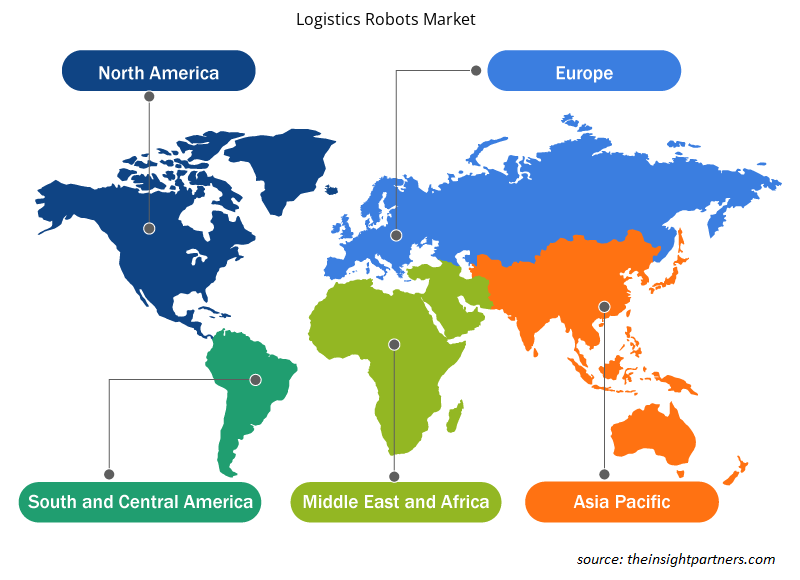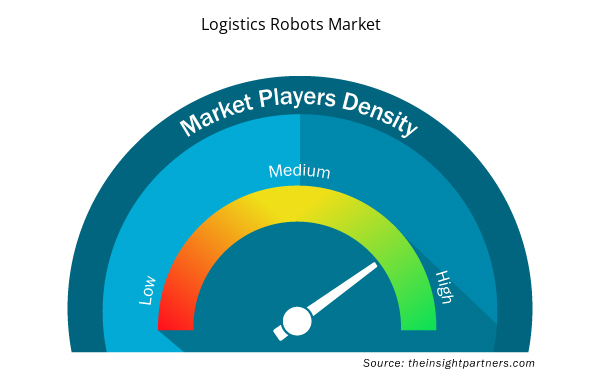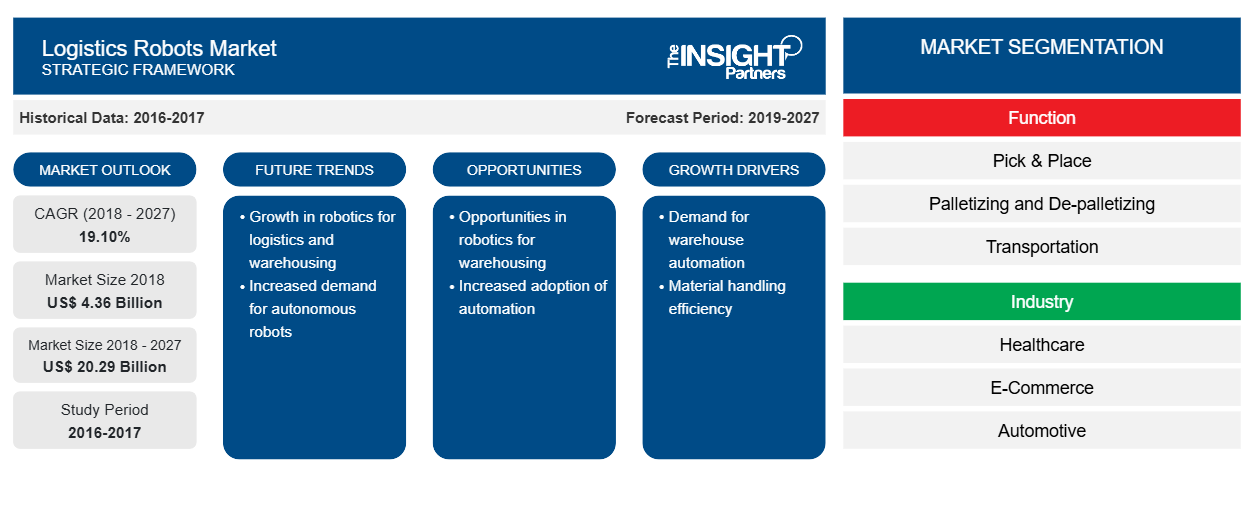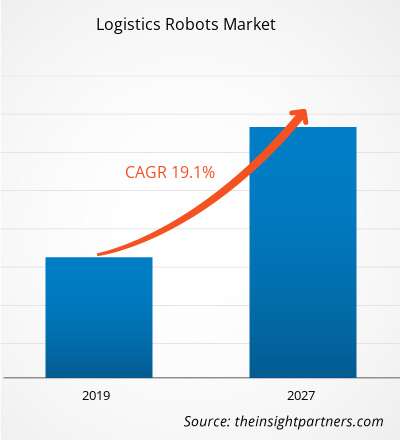El mercado de robots logísticos se valoró en US$ 4.356,2 millones en 2018 y se espera que crezca a una CAGR del 19,10% entre 2019 y 2027 para alcanzar los US$ 20.293,4 millones en 2027.
El aumento en el número de empresas de logística y almacenamiento que se centran firmemente en la incorporación de robots para obtener los beneficios de una mayor eficiencia, velocidad y mayores ganancias para seguir siendo competitivos en un mercado. La adopción de tecnología avanzada, como las tecnologías robóticas de almacenamiento y logística, está creciendo para mejorar la eficiencia operativa a un precio asequible. El mercado mundial de robots logísticos está impulsado por factores como un porcentaje creciente de la población que envejece a nivel mundial, lo que conduce a una escasez de mano de obra y al aumento de las redes de la cadena de suministro a nivel mundial, pero se anticipa que la alta inversión de capital para el despliegue de robots logísticos restringirá el crecimiento del mercado de robots logísticos durante el período de pronóstico. Sin embargo, es probable que la creciente automatización de los almacenes y el mercado bien establecido en los países de APAC y Europa brinden oportunidades de crecimiento sustanciales para mejorar la participación de mercado de los actores de la industria en el futuro cercano.
Perspectivas del mercado
El creciente porcentaje de población envejecida a nivel mundial conduce a una escasez de mano de obra
El creciente porcentaje de población envejecida en todo el mundo es uno de los principales factores de la reducción de la mano de obra en varias industrias. Cada país del mundo está siendo testigo de un aumento en el número de personas mayores en su comunidad. El envejecimiento de la población se ha convertido en uno de los factores sustanciales de las transformaciones sociales en el siglo XXI en todos los sectores, que abarcan tanto el mercado laboral como el financiero. Sin embargo, varios países como Italia, Japón y muchos más son los países que enumeraron el número máximo de la proporción de población envejecida, al considerar un porcentaje sustancial de su población mayor de 65 años. Según la OMS, se espera que ~ 2 millones de personas en todo el mundo tengan más de 60 años para el año 2050, lo que representa el triple de lo que era en 2000. El aumento en el número de población envejecida explicó la escasez de mano de obra. La implementación de robots logísticos en varias industrias juega un papel importante, ya que reduce el costo general del proceso, aumenta la productividad, mejora la seguridad y reduce el error humano. Los rápidos avances tecnológicos en los almacenes a nivel mundial están poniendo el foco en los requisitos relacionados con las dificultades a las que se enfrenta el proceso de la cadena de suministro y garantizando que la tecnología utilizada esté asociada con los objetivos comerciales. La implementación de robots en diferentes unidades, funciones y etapas de los ciclos de vida de los productos ha sido un desafío clave al que se enfrentan los almacenes en la actualidad en su camino de crecimiento, lo que, a su vez, impulsará el mercado de robots logísticos en el futuro cercano.
Personalice este informe según sus necesidades
Obtendrá personalización en cualquier informe, sin cargo, incluidas partes de este informe o análisis a nivel de país, paquete de datos de Excel, así como también grandes ofertas y descuentos para empresas emergentes y universidades.
- Obtenga las principales tendencias clave del mercado de este informe.Esta muestra GRATUITA incluirá análisis de datos, desde tendencias del mercado hasta estimaciones y pronósticos.
Información sobre los tipos de robots
El segmento de robots móviles colaborativos capturó la mayor participación en el mercado global de robots logísticos. Se están implementando en varias industrias para realizar una serie de tareas, como empaquetado, cuidado de máquinas y manipulación de materiales, ya que estos cobots son lo suficientemente competentes para manejar operaciones pesadas y livianas. Son altamente precisos, flexibles y exactos. Además, los cobots son fáciles de mantener y son más accesibles para reconfigurar y reprogramar. Estos robots también pueden manejar trabajos sensibles; además, se ajustan de acuerdo con las inconsistencias que ocurren durante los procesos de fabricación. Los cobots son capaces de recopilar métricas críticas para proporcionar análisis integrados, junto con informes, para simplificar el proceso de toma de decisiones que impulsa el mercado general de robots logísticos.
Información sobre funciones
El segmento de transporte capturó la mayor participación en el mercado global de robots logísticos. Las mercancías están paletizadas y hay una ligera variación en varias formas y tamaños de productos, lo que ha requerido la automatización para la carga y descarga de estas mercancías. La visión láser 3D está integrada con el nuevo software robótico, que ayuda a los usuarios con una visibilidad de diferentes productos en contenedores, determina la secuencia ideal de carga/descarga y lleva a cabo el proceso con una alta precisión. La robótica logística se utiliza para mover el estante objetivo, tirar y levantar la cesta, estirar la horquilla en el estante y devolver la posición objetivo, lo que impulsa el mercado general de robots logísticos.
Perspectivas de la industria
El segmento de logística subcontratada capturó la mayor participación en el mercado global de robots logísticos. Estos proveedores de servicios logísticos ofrecen diversos servicios, que incluyen almacenamiento, gestión de inventario, transporte, distribución, cumplimiento de pedidos y consolidación de carga. La creciente demanda de gestión de entregas oportunas, así como la reducción de costos de envío, mejoran el enfoque en mantener el registro de material en stock y el negocio principal y la reducción de los activos de la empresa, que se prevé que impulsen el mercado de robots logísticos durante el período de pronóstico.
Las empresas suelen adoptar varias estrategias de iniciativa de mercado para expandir su presencia en todo el mundo y satisfacer la creciente demanda. Esta estrategia se observa principalmente en Europa y la región APAC. Los actores presentes en el mercado de robots logísticos adoptan la estrategia de expansión e inversión en investigación y desarrollo para ampliar la base de clientes en todo el mundo, lo que también les permite mantener su marca a nivel mundial.
Perspectivas regionales del mercado de robots logísticos
Los analistas de Insight Partners explicaron en detalle las tendencias y los factores regionales que influyen en el mercado de robots logísticos durante el período de pronóstico. Esta sección también analiza los segmentos y la geografía del mercado de robots logísticos en América del Norte, Europa, Asia Pacífico, Oriente Medio y África, y América del Sur y Central.

- Obtenga datos regionales específicos para el mercado de robots logísticos
Alcance del informe de mercado de robots logísticos
| Atributo del informe | Detalles |
|---|---|
| Tamaño del mercado en 2018 | US$ 4.36 mil millones |
| Tamaño del mercado en 2027 | US$ 20,29 mil millones |
| Tasa de crecimiento anual compuesta (CAGR) global (2018-2027) | 19,10% |
| Datos históricos | 2016-2017 |
| Período de pronóstico | 2019-2027 |
| Segmentos cubiertos | Por función
|
| Regiones y países cubiertos | América del norte
|
| Líderes del mercado y perfiles de empresas clave |
|
Densidad de actores del mercado: comprensión de su impacto en la dinámica empresarial
El mercado de robots logísticos está creciendo rápidamente, impulsado por la creciente demanda de los usuarios finales debido a factores como la evolución de las preferencias de los consumidores, los avances tecnológicos y una mayor conciencia de los beneficios del producto. A medida que aumenta la demanda, las empresas amplían sus ofertas, innovan para satisfacer las necesidades de los consumidores y aprovechan las tendencias emergentes, lo que impulsa aún más el crecimiento del mercado.
La densidad de actores del mercado se refiere a la distribución de las empresas o firmas que operan dentro de un mercado o industria en particular. Indica cuántos competidores (actores del mercado) están presentes en un espacio de mercado determinado en relación con su tamaño o valor total de mercado.
Las principales empresas que operan en el mercado de robots logísticos son:
- AGV Internacional
- Robótica Clearpath
- Compañía Daifuku Ltd.
- Corporación Fanuc
- Buscar robótica inc.
Descargo de responsabilidad : Las empresas enumeradas anteriormente no están clasificadas en ningún orden particular.

- Obtenga una descripción general de los principales actores clave del mercado de robots logísticos
Mercado de robots logísticos: por tipo de robot
- Brazo robótico
- Vehículos guiados por correa
- Robots móviles colaborativos
- Otros
Mercado de robots logísticos: por función
- Recoger y colocar
- Paletizado y despaletizado
- Transporte
- Embalaje
Mercado de robots logísticos: por industria
- Cuidado de la salud
- Comercio electrónico
- Automotor
- Subcontratar logística
- Minorista
- Bienes de consumo
- Alimentos y bebidas
- Otros
Mercado de robots logísticos: por geografía
América del norte
- A NOSOTROS
- Canadá
- México
Europa
- Francia
- Alemania
- Italia
- Reino Unido
- Rusia
- Resto de Europa
Asia Pacífico
- Porcelana
- India
- Corea del Sur
- Japón
- Australia
- Resto de Asia Pacífico
Oriente Medio y África
- Sudáfrica
- Arabia Saudita
- Emiratos Árabes Unidos
- Resto de Oriente Medio y África
Sudamerica
- Brasil
- Argentina
- Resto de Sudamérica
Perfiles de empresas
- AGV Internacional
- Robótica Clearpath
- Compañía Daifuku Ltd.
- Corporación Fanuc
- Buscar robótica inc.
- Grupo Kion AG
- KNAPP AG
- Mañana de verano
- KUKA AG
- Corporación Toshiba
- Análisis histórico (2 años), año base, pronóstico (7 años) con CAGR
- Análisis PEST y FODA
- Tamaño del mercado Valor/volumen: global, regional, nacional
- Industria y panorama competitivo
- Conjunto de datos de Excel



Report Coverage
Revenue forecast, Company Analysis, Industry landscape, Growth factors, and Trends

Segment Covered
This text is related
to segments covered.

Regional Scope
North America, Europe, Asia Pacific, Middle East & Africa, South & Central America

Country Scope
This text is related
to country scope.
Preguntas frecuentes
Automated guided vehicles (AGVs) are used for consistent as well as predicted transport of materials. AGVs might be serviced through conveyors, forklift trucks, or manual cart transport systems. The transport of bulk materials using AGVs helps minimize efforts required in repetitive transportation of small chunks of materials, with less human intervention. Apart from distribution and manufacturing, AGVs have also become an integral part of other industries, including retail, military, food & beverages, automotive, and healthcare. The deployment of AGVs benefits businesses by reducing the cost of labor required in manual execution of tasks; enhancing safety, accuracy, and productivity of products; and improving the efficiency of work when integrated with the warehouse management/control systems. Improved work efficiencies further helps streamline other processes, such as materials ordering and inventory management.
With the increasing importance of equipment in logistic markets in APAC, especially China and India, robot manufacturers realize that electronics innovations can complement production innovations in gaining a competitive advantage. Japan is a well-developed economy and is one of the most technologically advanced economies across the world. Also, the region has a few significant manufacturers of robots and factory automation systems such as Fanuc, Mitsubishi Electric, and Omron Corp, among others. The Japanese companies widely use automation solutions to maintain their competitive position in the market.
The continuous growth in consumer expectations is likely to drive continued investment for the adoption of logistics robots for performing operational functions in warehouses. Leveraging the modern supply chain technology as well as the Internet of Things (IoT), the focus on the “smart warehouse†concept is growing, which can serve as a hub to enhance the efficiency and speed of the entire supply chain process. The warehouse automation includes wearable wore by workers to sensors, logistics robots, internet-enabled devices, and smart equipment, which profoundly modify the logistics management. Warehouse management is constantly facing more pressures related to supply chain transformation, commoditization, and rising customer expectations. Therefore, the warehouse automation concept is an effective way to enhance efficiencies, reduce operational costs, and scale operations. The warehouse automation performs various activities such as data collection and inventory control, with million-dollar of investments.
Trends and growth analysis reports related to Electronics and Semiconductor : READ MORE..
The List of Companies - Logistics Robots Market
- AGV International
- Clearpath Robotics
- Daifuku Co. Ltd.
- Fanuc Corporation
- Fetch Robotics Inc
- KION GROUP AG
- KNAPP AG
- Kollmorgen
- Kuka AG
- Toshiba Corporation
The Insight Partners performs research in 4 major stages: Data Collection & Secondary Research, Primary Research, Data Analysis and Data Triangulation & Final Review.
- Data Collection and Secondary Research:
As a market research and consulting firm operating from a decade, we have published and advised several client across the globe. First step for any study will start with an assessment of currently available data and insights from existing reports. Further, historical and current market information is collected from Investor Presentations, Annual Reports, SEC Filings, etc., and other information related to company’s performance and market positioning are gathered from Paid Databases (Factiva, Hoovers, and Reuters) and various other publications available in public domain.
Several associations trade associates, technical forums, institutes, societies and organization are accessed to gain technical as well as market related insights through their publications such as research papers, blogs and press releases related to the studies are referred to get cues about the market. Further, white papers, journals, magazines, and other news articles published in last 3 years are scrutinized and analyzed to understand the current market trends.
- Primary Research:
The primarily interview analysis comprise of data obtained from industry participants interview and answers to survey questions gathered by in-house primary team.
For primary research, interviews are conducted with industry experts/CEOs/Marketing Managers/VPs/Subject Matter Experts from both demand and supply side to get a 360-degree view of the market. The primary team conducts several interviews based on the complexity of the markets to understand the various market trends and dynamics which makes research more credible and precise.
A typical research interview fulfils the following functions:
- Provides first-hand information on the market size, market trends, growth trends, competitive landscape, and outlook
- Validates and strengthens in-house secondary research findings
- Develops the analysis team’s expertise and market understanding
Primary research involves email interactions and telephone interviews for each market, category, segment, and sub-segment across geographies. The participants who typically take part in such a process include, but are not limited to:
- Industry participants: VPs, business development managers, market intelligence managers and national sales managers
- Outside experts: Valuation experts, research analysts and key opinion leaders specializing in the electronics and semiconductor industry.
Below is the breakup of our primary respondents by company, designation, and region:

Once we receive the confirmation from primary research sources or primary respondents, we finalize the base year market estimation and forecast the data as per the macroeconomic and microeconomic factors assessed during data collection.
- Data Analysis:
Once data is validated through both secondary as well as primary respondents, we finalize the market estimations by hypothesis formulation and factor analysis at regional and country level.
- Macro-Economic Factor Analysis:
We analyse macroeconomic indicators such the gross domestic product (GDP), increase in the demand for goods and services across industries, technological advancement, regional economic growth, governmental policies, the influence of COVID-19, PEST analysis, and other aspects. This analysis aids in setting benchmarks for various nations/regions and approximating market splits. Additionally, the general trend of the aforementioned components aid in determining the market's development possibilities.
- Country Level Data:
Various factors that are especially aligned to the country are taken into account to determine the market size for a certain area and country, including the presence of vendors, such as headquarters and offices, the country's GDP, demand patterns, and industry growth. To comprehend the market dynamics for the nation, a number of growth variables, inhibitors, application areas, and current market trends are researched. The aforementioned elements aid in determining the country's overall market's growth potential.
- Company Profile:
The “Table of Contents” is formulated by listing and analyzing more than 25 - 30 companies operating in the market ecosystem across geographies. However, we profile only 10 companies as a standard practice in our syndicate reports. These 10 companies comprise leading, emerging, and regional players. Nonetheless, our analysis is not restricted to the 10 listed companies, we also analyze other companies present in the market to develop a holistic view and understand the prevailing trends. The “Company Profiles” section in the report covers key facts, business description, products & services, financial information, SWOT analysis, and key developments. The financial information presented is extracted from the annual reports and official documents of the publicly listed companies. Upon collecting the information for the sections of respective companies, we verify them via various primary sources and then compile the data in respective company profiles. The company level information helps us in deriving the base number as well as in forecasting the market size.
- Developing Base Number:
Aggregation of sales statistics (2020-2022) and macro-economic factor, and other secondary and primary research insights are utilized to arrive at base number and related market shares for 2022. The data gaps are identified in this step and relevant market data is analyzed, collected from paid primary interviews or databases. On finalizing the base year market size, forecasts are developed on the basis of macro-economic, industry and market growth factors and company level analysis.
- Data Triangulation and Final Review:
The market findings and base year market size calculations are validated from supply as well as demand side. Demand side validations are based on macro-economic factor analysis and benchmarks for respective regions and countries. In case of supply side validations, revenues of major companies are estimated (in case not available) based on industry benchmark, approximate number of employees, product portfolio, and primary interviews revenues are gathered. Further revenue from target product/service segment is assessed to avoid overshooting of market statistics. In case of heavy deviations between supply and demand side values, all thes steps are repeated to achieve synchronization.
We follow an iterative model, wherein we share our research findings with Subject Matter Experts (SME’s) and Key Opinion Leaders (KOLs) until consensus view of the market is not formulated – this model negates any drastic deviation in the opinions of experts. Only validated and universally acceptable research findings are quoted in our reports.
We have important check points that we use to validate our research findings – which we call – data triangulation, where we validate the information, we generate from secondary sources with primary interviews and then we re-validate with our internal data bases and Subject matter experts. This comprehensive model enables us to deliver high quality, reliable data in shortest possible time.


 Obtenga una muestra gratuita de este informe
Obtenga una muestra gratuita de este informe